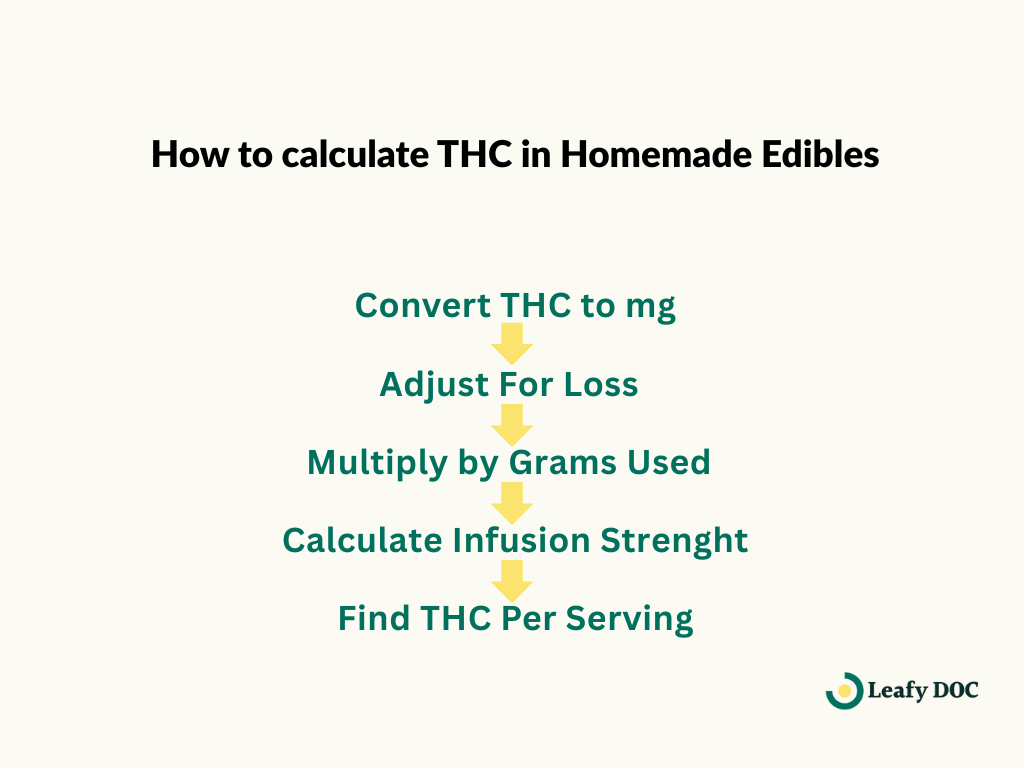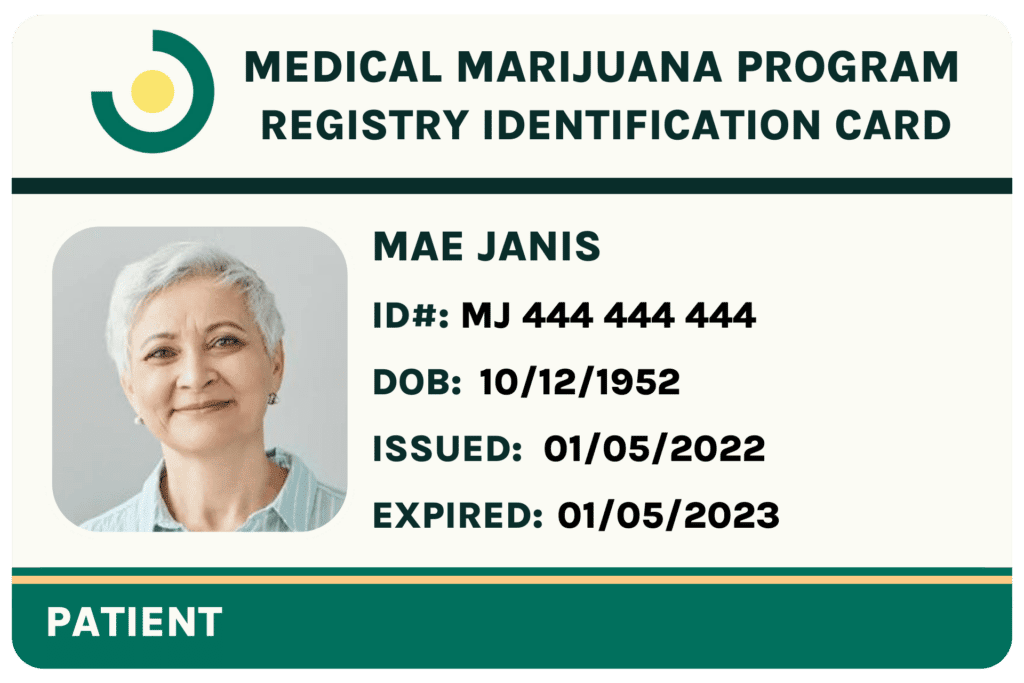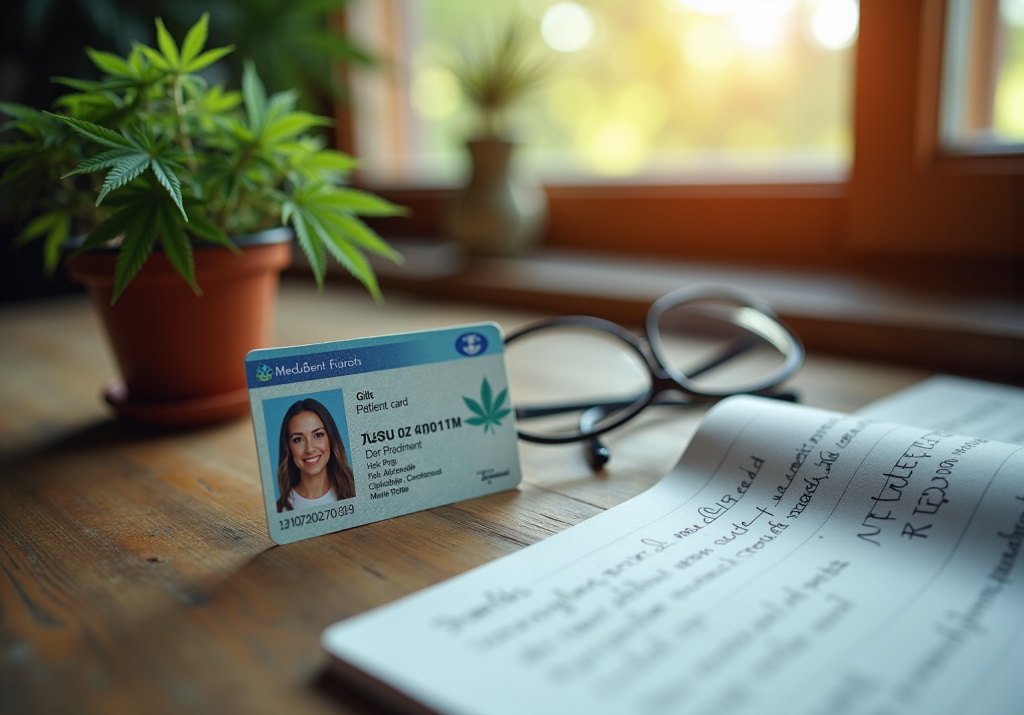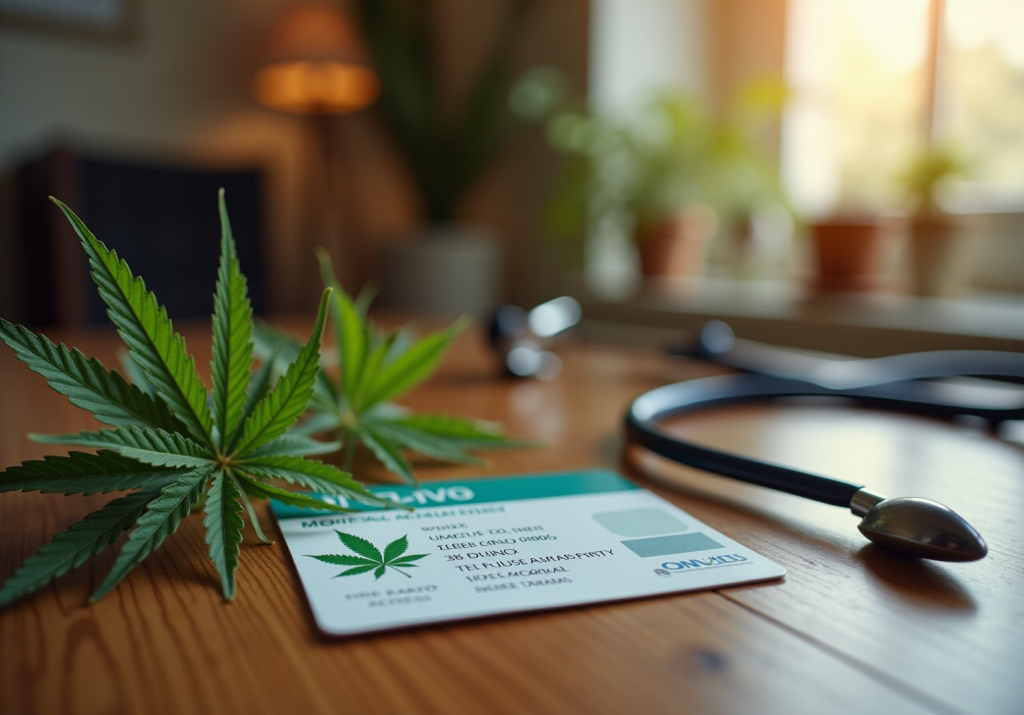Edible Dosage Calculator
Infusing Your Food With THC & CBD
Creating Portions/Servings
How to Calculate THc in Homemade Edibles
Calculating THC in homemade edibles is essential to know your dosage and avoid taking too much. Here’s how you can figure out the approximate THC content in your infused oil or butter:
Step 1: Convert THC Percentage to Milligrams
Start by converting the THC percentage on your cannabis flower label into milligrams per gram. Simply multiply the THC percentage by 10.
For example, if your flower has 17.7% THC, then:
17.7 × 10 = 177 mg THC per gram of flower.
Step 2: Adjust for THC Loss During Decarboxylation
Decarboxylation is a process of heating cannabis to activate THC and CBD. When you heat cannabis to activate THC, you lose about 20% of its potency. To adjust for this, multiply the total THC by 0.8 (or 80%).
So, 177 mg × 0.8 = 141.6 mg THC per gram after decarboxylation.
Step 3: Multiply by Total Grams of Flower Used
Now, figure out the total THC in your batch based on how much flower you use.
-
1 gram = 141.6 mg THC
-
3.5 grams = 495.6 mg THC (3.5 × 141.6)
-
7 grams = 991.2 mg THC (7 × 141.6)
Step 4(A): Estimate THC Per Teaspoon in Your Infused Oil
If you use 7 grams of decarboxylated flower in 14 fluid ounces of oil, you’ll end up with about 12 ounces of infused oil after heating.
There are 72 teaspoons in 12 ounces.
So, 991.2 mg ÷ 72 = 13.76 mg THC per teaspoon.
If you prefer a microdose (¼ teaspoon), that equals about 3.44 mg THC.
Step 4(B): Estimate THC Per Teaspoon in Your Infused Butter
If you use 7 grams of flower in 16 ounces of butter, you’ll likely end up with 14 ounces after heating.
There are 84 teaspoons in 14 ounces.
So, 991.2 mg ÷ 84 = 11.8 mg THC per teaspoon.
A ¼ teaspoon microdose equals about 2.95 mg THC.

What’s the Right THC Dose for Beginners?
For beginners, the right THC dose is typically between 1 to 5 milligrams. This small amount allows new users to experience the potential benefits of cannabis without feeling overwhelmed or uncomfortable.
-
1–2.5 mg (Microdose):
This range is best for first-timers. At this dose, most users don’t feel “high,” but they may notice relief from mild pain, anxiety, or nausea. It provides a gentle, clear-headed experience, perfect for understanding your body’s response to THC. -
3–5 mg (Low Dose):
Slightly higher doses can help with sleep, inflammation, and moderate pain. However, new users may begin to feel a mild “high” at around 5 mg. It’s important to start slow and wait at least two hours before taking more, as edibles take time to kick in.
In short:
If you’re new to cannabis, start with 1–2.5 mg of THC. Once you understand your tolerance, you can gradually increase to 3–5 mg if needed. Always follow the “start low and go slow” rule to ensure a safe and enjoyable experience.
| THC per dose | Dose category | What to expect | Edible recommendation |
|---|---|---|---|
| 1 – 2.5 mg | Microdose | Most users don’t experience intoxication at this dose, but may feel that their pain, anxiety, and nausea have abated without affecting their cognition. | Mints |
| 3 – 5 mg | Low | This dose helps with pain, nausea, inflammation, and may help with sleep. New users will likely feel a degree of intoxication, including feeling less coordinated and more silly. A 5mg dose is when a “high” begins to set in for many new and/or inconsistent consumers. | Infused seltzer, some gummies, honey sticks |
| 10 – 15 mg | Moderate | This is an ideal dose for more experienced users looking to have fun, sleep, or manage pain. New users may feel overwhelmed. | Gummies, single-dose baked goods, savory snacks, some beverages |
| 20 – 30 mg | High | This dose is only recommended for experienced edible consumers: expect strong euphoria and impaired coordination and/or perception. May be beneficial for chronic illness, insomnia, or severe pain. | Infused chocolate bars, THC-infused condiments |
| 50 – 100 mg | Acute | An effective dose for experienced users seeking relief from intense physical pain, PMS, MS, cancer treatment, and other conditions. Not recommended for those dealing with mental health issues. May cause nausea or disrupt the emotions of inconsistent consumers. | Infused baked goods |
| 100 – 500 mg | Macrodose | A useful dose for patients with GI absorption issues and other severe medical conditions like cancer. This is an intensely intoxicating dose, and many users risk experiencing adverse effects. Consume with caution and intention. | Infused shots and sodas |
wHAT IS THE RIGHT CBD Dosage?
This table provides a general guide for CBD dosage based on body weight. It categorizes doses into low (starting), medium, and high ranges to help users determine the right amount for their needs. Beginners are advised to start with the low dose and gradually increase if necessary, while always consulting with a healthcare professional for safety.
CBD Dosage Chart
| Body Weight | Low (Starting) Dose | Medium Dose | High Dose |
|---|---|---|---|
| 100 lbs | 10-20 mg | 21-49 mg | 50-60 mg |
| 110 lbs | 11-22 mg | 23-54 mg | 55-66 mg |
| 120 lbs | 12-24 mg | 25-59 mg | 60-72 mg |
| 130 lbs | 13-26 mg | 27-64 mg | 65-78 mg |
| 140 lbs | 14-28 mg | 29-69 mg | 70-84 mg |
| 150 lbs | 15-30 mg | 31-74 mg | 75-90 mg |
| 160 lbs | 16-32 mg | 33-79 mg | 80-96 mg |
| 170 lbs | 17-34 mg | 35-84 mg | 85-102 mg |
| 180 lbs | 18-36 mg | 37-89 mg | 90-108 mg |
| 190 lbs | 19-38 mg | 39-94 mg | 95-114 mg |
| 200 lbs | 20-40 mg | 41-99 mg | 100-120 mg |
| 210 lbs | 21-42 mg | 43-104 mg | 105-126 mg |
| 220 lbs | 22-44 mg | 45-109 mg | 110-132 mg |
| 230 lbs | 23-46 mg | 47-114 mg | 115-138 mg |
| 240 lbs | 24-48 mg | 49-119 mg | 120-144 mg |
| 250 lbs | 25-50 mg | 51-124 mg | 125-150 mg |
| 260 lbs | 26-52 mg | 53-129 mg | 130-156 mg |
| 270 lbs | 27-54 mg | 55-134 mg | 135-162 mg |
How to Consume THC Edibles Safely
1. Read labels and understand the content
Always read the label before eating any THC or CBD edible. Check the total amount and per serving of THC or CBD edible. This helps you calculate your dose correctly and prevents you from taking too much at once.
2. Choose quality products
Only buy edibles from trusted and licensed sources. Quality products go through strict testing for purity and accurate dosing, ensuring a safe and reliable experience without the risks that come with unregulated products.
3. Create the right environment
Your surroundings can greatly affect your experience. Choose a calm, familiar place and stay with people you trust, especially if it’s your first time. A comfortable setting helps you enjoy the effects safely and peacefully.
4. Start low and go slow
If you’re new to edibles, begin with a low dose (1–2.5 mg of THC). Wait at least two hours before taking more, since edibles take longer to work than smoking or vaping. Increasing the dose slowly helps you find your comfort level and avoid unpleasant effects.
Can You Overdose on THC, and What Happens If You Take Too Much?
Yes, it’s possible to take too much THC, but unlike many other substances, a THC overdose is rarely life-threatening. However, consuming too much can cause several uncomfortable side effects that may feel overwhelming, especially for beginners.
Common side effects of taking too much THC include:
-
Anxiety or panic
-
Paranoia
-
Nausea and vomiting
-
Increased heart rate or blood pressure
-
Confusion or disorientation
-
In severe cases, hallucinations or delusions
Why edibles can increase the risk:
Edibles are more likely to cause an overdose because they take longer to work. When people don’t feel the effects right away, they might take a second dose too soon, not realizing that their body is still processing the first one. Once both doses take effect, the results can feel much stronger than expected.
What to do if you’ve taken too much:
If you ever consume too much THC, stay calm and patient. The effects will wear off with time. Try to rest in a safe, comfortable space, drink water, and focus on breathing slowly.
However, if you or someone you know experiences severe vomiting, confusion, extreme anxiety, or aggressive behavior, seek medical help immediately.
what are the Symptoms of CBD Overdose
Although CBD is generally considered safe, taking high doses can cause adverse effects. Be aware of these potential symptoms, especially when starting or adjusting your dosage:
-
Dry mouth
-
Anxiety
-
Nausea and vomiting
-
Diarrhea
-
Changes in appetite
-
Psychosis
-
Drowsiness
-
Dizziness
If you notice any of these symptoms after using CBD, it’s recommended to reduce your dose or stop use and consult a healthcare professional.
How Long Does It Take to Feel the Effects of Edibles?
Edibles usually take 30 to 60 minutes to take effect. However, the exact onset time can vary depending on several factors:
-
THC Concentration: Edibles with higher doses or stronger THC concentrations may kick in faster.
-
CBD-Only Products: CBD edibles are not psychoactive, so they don’t produce the typical “high.” Effects may be subtler and harder to notice.
-
Digestion and Absorption: Onset also depends on how your body breaks down and absorbs the edible into your bloodstream.
What are the Benefits of Edibles
Cannabis-infused edibles offer several advantages over smoking:
-
No Respiratory Risk: Smoking cannabis exposes the lungs to carcinogens and can cause inflammation or bronchitis. Edibles avoid smoke entirely, reducing these risks.
-
Longer-Lasting Effects: There are multiple CBD edibles for wellness. These Edibles take longer to wear off compared to smoking or vaping, making them ideal for medicinal users seeking extended relief.
-
Accessible: Edibles are easy to consume without going outside or using smoking equipment, making them suitable for those who cannot or prefer not to smoke.
-
Discreet: Edibles can be taken without drawing attention. They produce no strong odor, which is helpful for users who need medicinal relief at work or in public.
Frequently Asked Questions
Get Your Medical Card
Connect with a licensed physician online in minutes





